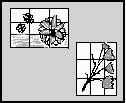Several hints were given at our meeting a few years ago on how to take better floral photographs. Thank you to Lynn Shea who was willing to be a teacher as well as a judge!
- Always use a tripod.
- Photographing a flower in direct sunlight overexposes all or part of the flower, causing it to lose the detail. The same is true when photographing people. It is better to photograph flowers or people in light shade or on an overcast day. You can create light shade by using a diffuser. (A cheap way is to use a piece of wax paper! Just be sure you have a way of holding it where you want it.)
- If it is too dark in the shade, you can use a reflector to put a glow on the flower. (Cheap way— use aluminum foil as a reflector.)
 Do not center your flower. Remember the rule of thirds: If you divide your photo into 9ths, (think Tick Tack Toe) the best place for the focus of the photo is in the corners or along the sides.
Do not center your flower. Remember the rule of thirds: If you divide your photo into 9ths, (think Tick Tack Toe) the best place for the focus of the photo is in the corners or along the sides.- Creating a diagonal movement in the photo gives an attractive appearance. (See the lovely tulip stems in the above drawing.)
- When indoors, photographing flowers near a window gives nice soft light. Be sure to avoid direct sunlight.
- Keep your background uncluttered. This is true for portraits, also, unless you are trying to associate the subject with a specific location or mood.
- To keep the background blurred (which makes it look less busy,) use a low aperture number. But do not go too low, or all of the flower will not remain in focus from front to back. For another way, try photographing the flower in very low light and setting the shutter speed at 6 seconds, (more or less—you’ll need to experiment.) Obviously, a tripod is necessary. Note: this is not possible with a camera that is completely automatic. Other thoughts for floral photography:
- Use a tripod mounted camera with an f/22 or higher with a macro lens, or just really close, pop a strobe on it and see what happens…especially of the strobe is off to the side. If you want to blow out the background with a long lens then use the largest aperture opening you can get or with a macro, pump the aperture up to between 8-22 to get mere inches in focus. And a way to make a diffuser is with a white bed sheet, which can be stretched
- Fill the space with the subject you are photographing. Do not leave large amount of sky or background.
- If you want to create a water drop effect on a flower, you can use a spray bottle with a little glycerin in the water.
- It is usually not a good idea to cut off the tips of the petals in the photograph.
ALL THE ABOVE ARE ONLY SUGGESTIONS. RULES ARE MADE TO BE BROKEN!
